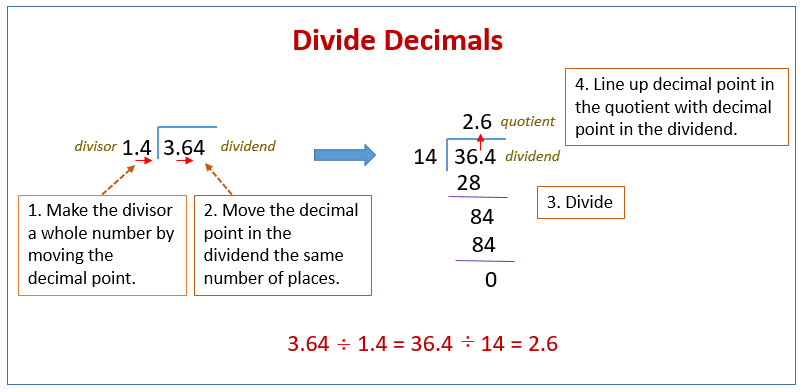



Decimals
A number whose whole number part and the fractional part is separated by a decimal point.

Steps for rounding decimals:
Ex: 0.567 round to nearest tenth
We will determine that the number in the tenths place is the number five. The Number six is to the right of that number and it is greater than 5 therefore are number rounded to the nearest tenths position is 0.6
Changing Decimals to Fractions
Rewrite the decimal to be over 1 to create a numerator and denominator. The one will be your denominator.
Multiply the numerator and the denominator by 10 to the power of the number of digits after the decimal point. For instance if there is only one value after the decimal point multiply by ten, two multiply by 100, three multiply by 1000 etc
Express the fraction in simplest or reduced form

Adding and subtracting decimals
Example:
Dividing Decimals
Moved the decimal point in the divisor to make a whole number. move the dividend the same amount of times. Move the decimal up to the top. Divide as usual. Keep dividing until the answer terminates or repeats.
The number we divide by is called the divisor.
Example:

When dividing a whole number by a decimal, change the decimal to a whole number by moving the decimal point to the right until you get a whole number. Divide the whole number by the new number to get your answer. Make sure you move the decimal point over the same amount of times when you first moved the decimal point. This will be the answer to the original problem.
Example:
40 / .05 =
we will first move the decimal point over to the right to change the .05 to a whole number. We move the decimal over two spaces to the right to get 5.
40 / 5
Answer would be 8. We now have to move the decimal point over to the right two times like we did in the first step.
The final answer will be 800.
40 / .05 = 800
Multiplying Decimals
Line up the last digits on the right not the decimals.
Multiply like you multiply whole numbers.
To determine where the decimal goes add the decimal places in both numbers together. Than move the decimal to the left that many times.
Example:

